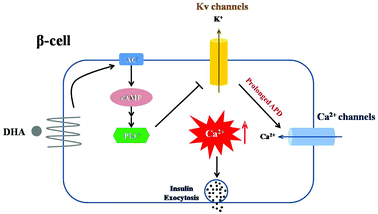Inhibition of voltage-gated K+ channels mediates docosahexaenoic acid-stimulated insulin secretion in rat pancreatic β-cells
Abstract
Docosahexaenoic acid (DHA), an omega-3 polyunsaturated fatty acid, plays an important role in regulating glucose metabolism. The aim of this study was to investigate the effect of DHA on insulin secretion and the underlying ion channel mechanism in rat pancreatic β-cells. The insulin secretion results illustrated that DHA promoted insulin secretion in a glucose-dependent manner. Calcium-imaging analysis indicated that DHA elevated intracellular Ca2+ concentration. Using the patch-clamp technique, we found that DHA prolonged the action potential duration (APD) and significantly inhibited voltage-dependent K+ (KV) channels, but did not act directly on voltage-gated Ca2+ channels. Furthermore, our data demonstrate that the insulinotropic effect of DHA was mediated by G protein-coupled receptor 40 (GPR40) as well as the adenylyl cyclase (AC)/cyclic adenosine monophosphate (cAMP)/phospholipase-C (PLC) signaling pathway. Together, these findings illustrate that KV channels play a vital role in DHA-augmented insulin secretion through a mechanism whereby DHA blocks KV channels via GPR40 and the AC/cAMP/PLC signaling pathway in rat pancreatic β-cells.



 Please wait while we load your content...
Please wait while we load your content...